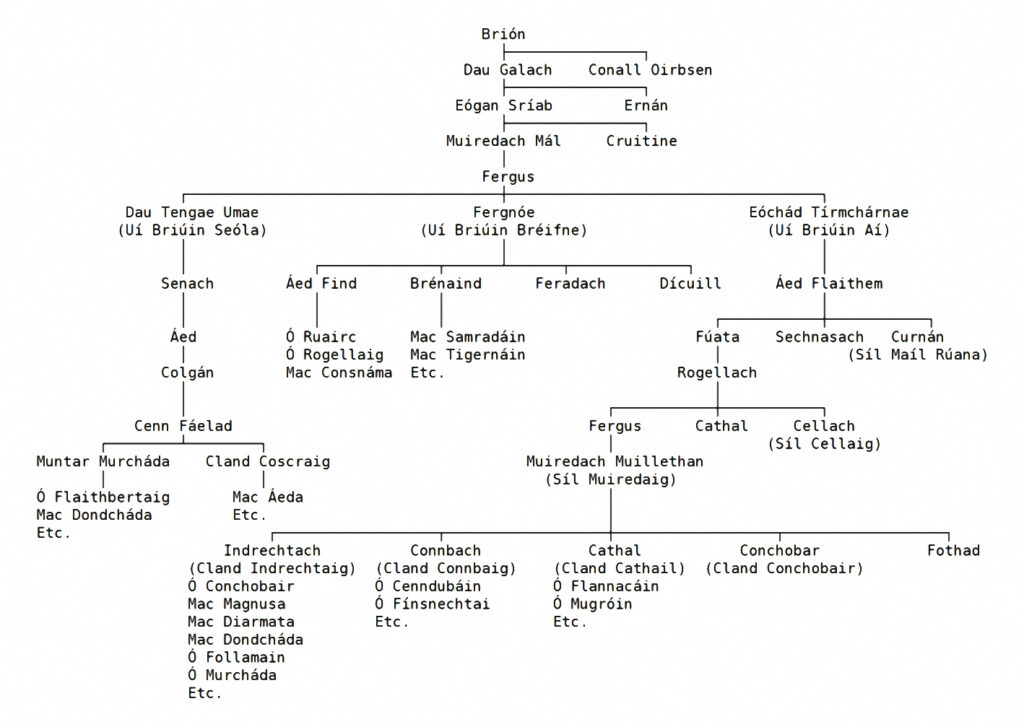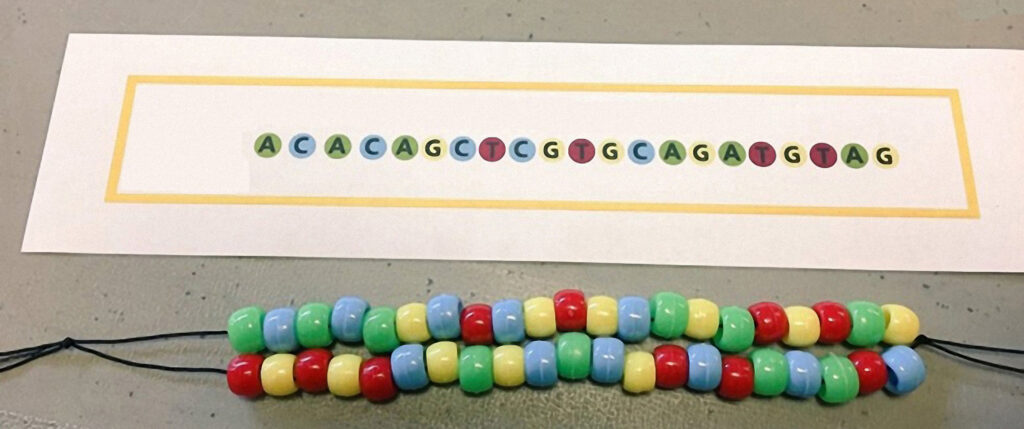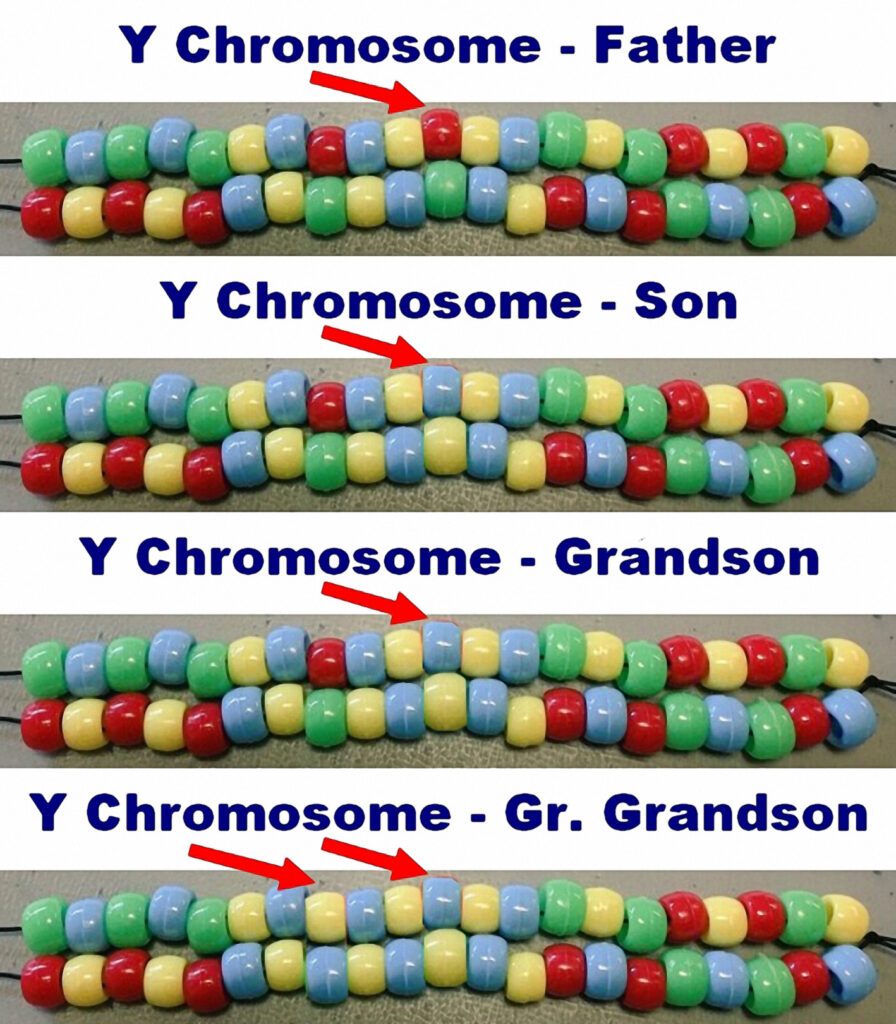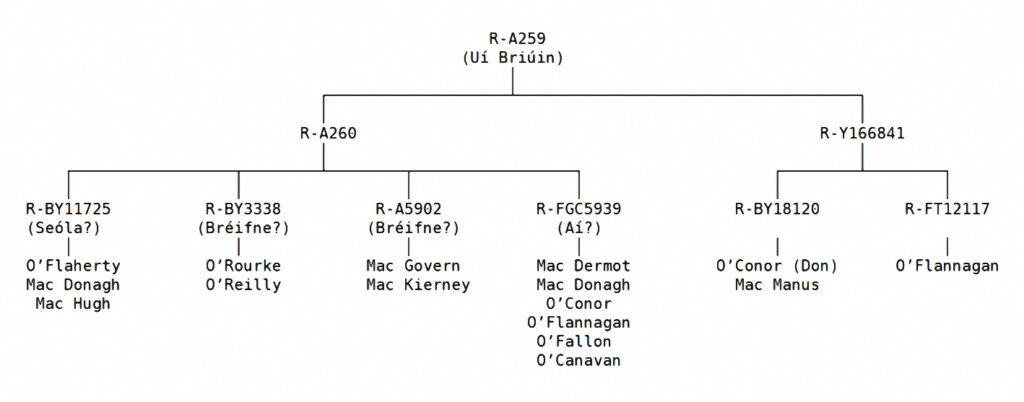By David C. Mac Donagh
DNA is being used for genealogy in various ways, but especially by taking men’s Y-chromosome data in combination with their modern surnames to correlate with historical genealogies. A lot of work has been done on this for several of the recorded Irish dynastic groups; the focus of this article is on one of the better-known dynastic groups in medieval Irish history, the Uí Briúin of Connacht. These are the descendants of Brión, one of the Connachta progenitors, who died c. AD 386.

THREE BRANCHES OF THE UÍ BRIÚIN
Historically, the Uí Briúin have been divided into three distinct branches: the Uí Briúin Seóla, the Uí Briúin Bréifne and the Uí Briúin Aí. This genealogy, as taken from the Book of Ballymote and presented in Table 1 (p. 16), is consistent across all texts that the author is aware of and is thus an anchor point. The three branches arise from the three sons of Fergus—Dau Tengae Umae (Uí Briúin Seóla), Fergnóe (Uí Briúin Bréifne) and Eóchád Tírmchárnae (Uí Briúin Aí). The dominant sept of the Uí Briúin Aí is the Síl Muiredaig (Silmurray), and historically the senior family of the Silmurray is the Ó Conchobair (O’Conor), particularly in the later period the Ó Conchobair Dond (O’Conor Don) branch. The second pre-eminent family is the Mac Diarmata (Mac Dermot). Both of these families have verified pedigrees dating from the tenth century from their common paternal ancestor, Tadc inda Dúir Ó Conchobair, who died c. 956.
DNA TYPES

Until recently, the only resources that have been available for Irish genealogy are the surviving written genealogies, annals and histories. Starting in the early 2010s, however, commercial DNA sequencing has made it possible to decipher the structure of an individual’s chromosomes. It was found that there are variants/changes/mutations between the DNA of individuals, and these variants can be used for genealogical purposes. There are numerous articles, papers, blogs etc. online that explain how this works in detail but, simply put, DNA used for genealogical purposes can be categorised into three major types: autosomal DNA (AT-DNA), mitochondrial DNA (MT-DNA) and Y-chromosome DNA (Y-DNA).
AT-DNA is used by companies such as Ancestry, 23andMe etc. and consists of the 22 non-gender-determining chromosomes. It is only genealogically useful to roughly six generations back from the tester. MT-DNA comes from cellular mitochrondria, not a chromosome, and is found in both men and women. It can be used to determine the tester’s maternal lineage back for millennia. However, the variants in the MT-DNA between a mother and her child occur so infrequently that sometimes there are millennia between variant occurrences. Y-DNA is different from the other two types of DNA. It comes from the Y chromosome, which only men have, and is passed strictly from father to son. Variants in the Y chromosome occur roughly every other generation, so Y-DNA can be used to trace a man’s paternal lineage all the way back to Genetic Adam, the one man from whom the entire human race descends.
‘STRINGS OF BEADS’
Figure 1 (p. 17, top) shows the familiar DNA double helix. The Y chromosome has this same structure. When we untwist the helix, we have something like Fig. 2 (p. 17, bottom), with the Y chromosome ‘untwisted’. There are two parallel ‘strings of beads’. Each ‘bead’ is called a nucleotide and there are only four different nucleotides, or only four different colours of ‘beads’. The colours are given letter designations: A, C, G and T. The two parallel strings or strands are complementary to each other because each colour can only pair with one other specific colour: A with T and C with G. The corresponding ‘beads’ on each strand are called a base pair.

One strand of the ‘string of beads’ of the Y chromosome is approximately 62 million ‘beads’ long, so the Y chromosome has approximately 62 million base pairs. Consequently, there are plenty of places for variants to occur, and, except for a few rare cases, the variants are unique.
The ‘knots’ on each end of the string are different from each other, so we always know which is the ‘left’ end and which is the ‘right’. And since the two strands are complementary to each other, we only need to examine one strand to understand the Y chromosome’s sequence of ‘beads’.

Since only men have a Y chromosome, a son can only inherit his Y chromosome from his father. There is no contribution from his mother, unlike with the other chromosomes in human DNA. In a perfect world, the same sequence of ‘coloured beads’ would be passed on from father to son, so that all men everywhere would have the exact same ‘string of beads’ for their Y chromosome passed on from Genetic Adam.
VARIANTS
The Y-chromosome transmission process sometimes hiccups, however, and a variant is introduced that causes the son’s ‘string of beads’ to be different from the father’s. A few generations later, a different hiccup occurs that introduces a second variant, and so on through the ages. Each variant is retained and transmitted to all male descendants in that line.
In Fig. 3 (p. 18) the son has a change which is transmitted to the grandson, so the son and grandson have the same ‘string of beads’ for their Y chromosome. But there is another hiccup in the great-grandson, who now has two variants compared to the original father: the one introduced in the original son and now the new one introduced in him. These types of variants are called SNPs (single nucleotide polymorphisms). There are other, more complex variants that occur as well, but the effect is the same. These variants can be detected during sequencing of the Y chromosome, within the limits of the sequencing equipment, and have been used to build a Y-Haplotree that shows where each man’s Y chromosome differs from all other men. The addition of a new variant causes a branch point on the Y-Haplotree, which defines a new clade/haplogroup/branch.

If one son has a new mutation but another son does not, we can determine from which son a man descended by looking at his Y chromosome and seeing which variants he has—that is, which ‘beads’ have changed colour in one son and his male descendants but not in the other. It is the accumulation of all a man’s variants that allows us to determine which clade he belongs to on the Y-Haplotree. Men with a common paternal ancestor all belong in the same clade.
So the Y-Haplotree is exactly like a family tree but, rather than showing each genealogical generation, it shows every variant generation. A Cladogram is a Y-Haplotree with the modern surnames of the testers added to their respective clades. The Y-Haplotree used here is based on the GRCh38 human genome reference, which is one of the most widely used currently.
Despite all the Y-DNA test data amassed to date, the Y-Haplotree is by no means complete. It is growing and changing daily, as new test data are collected and analysed and new variants are discovered; nevertheless, while the new test data do change the Y-Haplotree and its corresponding Cladogram, at this point in time a major change seems unlikely. Rather, the new test data are providing refinements, not wild upheavals, and the Y-Haplotree remains genealogically relevant. However, the available Y-DNA test data are limited to men who choose to do Y-DNA testing and to make their test data public. This is why some clades are sparse and others are nicely populated. There is still a big need for more men to do Y-DNA testing.

CORRELATION
The type of correlation used between the Y-DNA in combination with modern surnames and the historical genealogies is that of statistical correlation. Typically, the two datasets are numerical in nature and correlation involves the use of mathematical calculations. However, correlation can also be achieved graphically by taking graphs of the two datasets and moving one around on top of the other until a point of maximum congruence/alignment is found. In this case, a graph of the Irish genealogical family trees can be overlaid onto a Cladogram and the two can be compared for the point of maximum congruence.
ALTERNATIVE UÍ BRIÚIN GENEALOGY
Paul Duffy, an administrator of the Family Tree DNA (FTDNA) Irish yDNA Project, first started noticing a clustering of Uí Briúin surnames in the R-A259 clade c. mid-2014. Subsequent work, beginning in 2017, was the start of a concerted effort to flesh out the Y-Haplotree under the R-A259 clade by members of three unaffiliated groups (although individuals do participate in more than one). The original group is the Dál Cuinn, Teóra Connachta and the Uí Néill M222, R-DF105 and DF104 group on Facebook. The second is the Dál Cuinn, Teóra Connachta and the Uí Néill DNA Project at FTDNA. The third is the Genelach Dáil Cuinn Project™ network of independent researchers. Although unaffiliated, all three groups participate in a continuing collaborative effort that has amassed an amazing amount of Y-DNA test data from men who are in the R-A259 clade.
An alternative Uí Briúin genealogy is shown in Table 2 (p. 19, top). Peter O’Connell, an eighteenth-century antiquarian, showed in his list of ‘The Christian Kings of Connacht’ a genealogy in which Muiredach Mál had two sons, Fergus and Cathal. This genealogy is echoed by Hubert Thomas Knox in his book The history of the county of Mayo to the close of the sixteenth century. It should be noted that the descendants of both Fergus and Cathal were kings of Connacht at various times.
This alternative genealogy is important because recent Y-DNA testing has called into question the centuries-old ‘fact’ that the O’Conor Don and related branches are the senior line of the Silmurray. Instead, there is strong scientific evidence that all of the later O’Conor branches are not even Silmurray, thus making the Mac Dermot family the senior line, genetically speaking.
Dr Kieran D. O’Conor of the O’Conor Don line graciously consented to have his Y-DNA tested in 2020, paid for by the FTDNA Dál Cuinn, Teóra Connachta and the Uí Néill DNA Project. It provided amazing data showing strong evidence of the R-A259 clade being the primary Uí Briúin clade. Dr O’Conor’s test results place him in the R-Y166841 subclade.
In 2023 Mr Francis Mac Dermot, currently The Mac Dermot and Prince of Coolavin, was persuaded to do Y-DNA testing by Michael Rowley, a researcher for the Genelach Dáil Cuinn Project™ network of independent researchers. This produced a surprising result, as Mr Mac Dermot’s test data show that he is in the R-A260 subclade, in particular the R-FGC5939 subclade. He was anticipated to be in the same R-Y166841 subclade as Dr O’Conor, according to the majority of the traditional genealogies. But since he was not, this raised a major discrepancy between the written genealogy and the Y-DNA.
The current partial Cladogram of R-A259 is shown in Table 3 (p. 19, bottom). This comes from the Genelach Dáil Cuinn Project™ Cladogram. Small subclades with few testers have been excluded owing to the lack of Y-chromosome sequencing coverage, which makes it difficult to determine the exact variant composition.
Although the Uí Briúin Bréifne surnames are split across the R-BY3338 and R-A5902 subclades, this is readily explained by the fact that variants do not necessarily occur in every generation. It is quite possible that Fergnóe himself had no new variants but that his credited four sons did. The surnames in the R-BY3338 subclade are associated with the descendants of Áed Find, and those in the R-A5902 subclade are associated with Brénaind. The small subclades under the R-A260 subclade that have been excluded owing to too few testers might be attributable to the two obscure sons, Feradach and Dícuill.
Regardless, when graphically correlating Tables 1 and 3 it becomes apparent that there is no good alignment between the Irish genealogies and the Cladogram. There is no acceptable congruence with the anchor point of Fergus’s three sons because it is effectively impossible for the descendants of two brothers to belong in the R-A260 subclade while the descendants of the third brother do not.
On the other hand, when graphically correlating Tables 2 and 3 it is apparent that aligning the R-A260 subclade to Fergus maximises congruence between the Irish genealogies and the Cladogram, and so preserves the anchor point of his three sons. However, based on this alignment, there is a glaring discrepancy with the O’Conor Don being in the R-Y166841 subclade.
Again, the only recorded explanation that the author has found for this unexpected genetic divergence between the O’Conor Don and Mac Dermot families is the genealogy shown in Table 2. And, given the prevalence of Silmurray surnames in the R-FGC5939 subclade under the R-A260 subclade, the most logical conclusion is that the Silmurray are in the R-FGC5939 subclade with the Mac Dermot family, not in the R-Y166841 subclade where the O’Conor Don and Mac Manus families are.
It therefore appears that somewhere between Tadc inda Dúir Ó Conchobair, the last shared ancestor of the O’Conor Don and Mac Dermot families, and Tairdelbach Már Ó Conchobair, who died c. 1156 and was the progenitor of the O’Conor Don and other later O’Conor branches, there was a Surname Change Event (SCE). There are many reasons besides bastardy, such as adoption or fosterage, why this could have happened. Precisely when this SCE occurred is unclear as of yet and may never be ascertainable.
Regardless, belonging to this second, Uí Briúin, Maicne Cathail branch in no wise negates the importance of the later O’Conor branches, in particular the O’Conor Don. They too descend from Uí Briúin kings of Connacht, even if they are not from the Uí Briúin, Maicne Fergusa, Síl Muiredaig line. Y-DNA is proving that sometimes beloved tradition is wrong, as in this case. The Mac Dermot are demonstrably Síl Muiredaig while the later O’Conor are not.
David C. Mac Donagh is an independent researcher for the Genelach Dáil Cuinn Project™ and webmaster for the associated website, https://genelach.network/.
Further reading
R. Estes, ‘4 kinds of DNA for genetic genealogy’, in DNAeXplained—Genetic Genealogy (1 October 2012) (https://dna-explained.com/2012/10/01/4-kinds-of-dna-for-genetic-genealogy/).
‘Mitochondrial Eve’ (28 November 2024), https://en.wikipedia.org/wiki/Mitochondrial_Eve.
‘Uí Briúin’ (24 November 2024), https://en.wikipedia.org/wiki/Uí_Briúin.
‘Y-chromosomal Adam’ (4 December 2024), https://en.wikipedia.org/wiki/Y-chromosomal_Adam.
This is an edited version of the winner of the 2025 Irish Chiefs’ and Clans’ Prize in Gaelic History. See https://www.tcd.ie/history/irishclansandchiefsprize.php for information on the 2026 competition.
